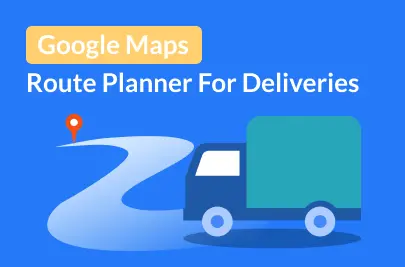Route Planning Vs Route Optimization: What’s The Difference?


“Route planning” and “route optimization” are often used interchangeably, and it can be hard to understand the difference. So here it is in a nutshell: route planning is the process of creating a plan for visiting a set of locations, while route optimization is finding the most efficient or cost-effective way to complete that journey.
People have been planning routes for as long as they’ve been moving around the world. Our remote ancestors planned their seasonal migrations around watering holes and food sources – today, we plan around traffic obstacles and tolls. What’s new is that today’s route planners can get help from cloud computing and sophisticated algorithms. For the first time, it’s possible to be confident that we’re planning optimal routes.

Why route optimization matters
The most complex kind of route planning, typically involving organizations that make deliveries or field service calls, involves fleets of vehicles that need to visit multiple locations in a single journey. There are usually a bunch of constraints to meet, too: the route has to fit with driver schedules, different loads need different vehicles, and customers want predictable ETAs and delivery windows.
This is where the ability to optimize routes is a game-changer, with the potential for both financial, social and environmental gains. Here’s why:
An optimized route is the shortest route possible that meets real-world needs and constraints. A shorter, more efficient route means less time on the road, which in turn means:
- Lower fuel costs
- Increased profitability
- Lower emissions
- Less wear and tear on vehicles
- Less traffic congestion
- More safety for delivery drivers and other road users
Google Maps + a spreadsheet can’t do really route optimization
What about Google Maps, you ask? It’s a really great navigation app! So why not use it to do delivery route planning and route optimization as well?
Full disclosure: we love free software as much as anyone. We’ve even written a whole article about how to optimize delivery routes with Google Maps and an excel spreadsheet. The truth is, it’s a pain. It takes a long time, it’s fiddly, and it doesn’t give great results. Our experience is that people running delivery services try manual route planning like this for a while, then realize the amount of time and hassle they’ll save by using proper route planning software make the investment totally worth it. (If you want to test the difference for yourself – Routific is free to try for seven days).
That’s why the rest of this post will focus on what you can do with specialized route planning software – which is a lot more than just creating a sequence of stops!
Driver acceptability is a key characteristic of an efficient route
At Routific we’ve learned, from many hours of talking to our customers, that an optimal route is also a route that makes sense to humans, especially drivers. Take a look at the picture below, which shows two different route optimization solutions for the same set of stops in the suburbs north of Los Angeles:
.webp)
The solution on the right shows what we call “clean clusters”: there’s very little overlap between adjoining territories and the routes look sensible to a human eye. On the left is what we call “spaghetti routes” that overlap and criss-cross each other — maybe they make sense to the algorithm that did the planning, but to humans it looks wasteful and inefficient.
We’ve heard from a lot of our customers that drivers hate seeing each other on the road — if I spot one of my colleagues just driving away from the area I’m heading into, it’s going to be hard to convince me that it wouldn’t have been more efficient to put both deliveries on one truck. If drivers lose faith in your route planning software and revert to doing it themselves, you’re back to square one. This is why driver acceptability is one of the things we keep a close eye on as we refine our algorithms.
The 5 steps of delivery route planning – route optimization and beyond
Route optimization is the “make it as efficient as possible” part of route planning. But there’s more to it than just routing! At Routific we think of route planning for last-mile deliveries as the part of delivery operations that starts with uploading the orders and continues through optimizing routes, inspecting and editing the routes, dispatching the routes to drivers, and finally communicating ETAs to customers.
1. Uploading orders
Route planning starts with uploading a list of stops and associated information to your route planning tool. You could do this via a direct upload of a CSV file, or via an API that links your route planner directly to your order taking system.
Information you may want to have in your upload includes:
- Customer name, address and contact details
- Delivery time windows
- Vehicle types and vehicle capacities
- Expected stop duration
- Preferred drivers
- Driver notes
Any route planning software currently available should have this functionality.
2. Optimizing routes
Actual route optimization is where the algorithm magic happens. It’s also where the differences between route optimization solutions really become obvious. The efficiency gains from route optimization depend entirely on how much shorter the routes are — and in our tests, uploading exactly the same list of stops to different route planners yields routes that vary by as much as 15% in length.
Take another look at these two routing solutions:

The Routific solution on the right is 15% more efficient than our competitor solution on the left. At around 700 orders, that translates to 125 miles. Now think about driving 125 more miles than necessary every day, and the impact on the bottom line is crystal clear.
Designing and updating route optimization algorithms is serious work, because the problem of calculating optimal routes is so notoriously hard. Nobody has ever cracked the problem of identifying THE most perfectly efficient route (if you want to know more about this, read our posts on the Traveling Salesman Problem and the Vehicle Routing Problem). Given any set of stops there are many possible good solutions, and only a few great solutions. The algorithm that reliably delivers the best route is the one you want to choose.
(Incidentally, this is also why there is no free route optimization solution anywhere. It’s just too much work to do for free).
What’s the difference between static and dynamic route optimization?
Static route optimization means you plan an optimal route once, then keep doing that same route over and and over again. This works when you have a regular, predictable set of deliveries like a milk round or newspaper delivery route.
Dynamic route optimization adjusts a route in response to new information, like new or canceled orders or a road closure. It’s what enables modern businesses to offer same- or next-day delivery. It’s also only possible because we have access to the computing power to make it possible. 20 years ago, static routing was really the only option available.
3. Inspecting and editing routes
Route planning software should definitely include the ability to edit and change routes. This is because nobody has ever cracked the problem of creating a multi-stop route that is THE most efficient route. All we can do is get as close as we can, which means there’s always a handful of different delivery routes to choose from. 99% of the time, the route the algorithm chooses is better than anything a human could do — but every now and then a couple of tweaks, like assigning a couple of stops to a different driver, couldn’t make it better.
There’s also the very common issue of having to accommodate last minute changes – unexpected traffic delays, a driver calling in sick, or a customer asking to delay their delivery. Changing up your routes to accommodate these in real time shouldn’t be a major production.
4. Dispatching routes to drivers
You can dispatch routes to your drivers using nothing more than a good-old fashioned printer and a clipboard – paper still has the advantage that it never needs to be charged, and it never loses signal. Or you could do a convenient one-click dispatch to a mobile app on a driver’s phone. Both methods work, so it comes down to the unique needs and preferences of your business, and your drivers. Your route planning software should give you the flexibility to do either.
5. Communicating ETAs to customers
Don’t you hate it when the best a company can do is tell you your order will arrive “sometime on Tuesday”? A lot of people plan their days around expected deliveries, so communicating accurate ETAs is an important part of creating a customer experience that people will want to repeat. Good route planning and route optimization software includes the ability to send notifications about expected deliveries automatically when a route is dispatched. Sending signatures or photo proof of delivery afterwards is an added customer satisfaction bonus.

Route planning and route optimization with Routific
So to sum up, what is route optimization? At Routific, this is our working definition: Route optimization generates the shortest routes possible, while still meeting real-world needs and constraints.
The “real world” part is important. Our mission is to make the benefits of route optimization accessible to every delivery business. We want to make the delivery process less time-consuming, help businesses control their operational costs, and contribute to reducing harmful emissions. We like to think that for dispatchers and delivery managers, using route optimization software is like putting on an Iron Man suit: it makes one person a lot more powerful.
Frequently Asked Questions
Related articles
Liked this article? See below for more recommended reading!

Route Planning Tips For Small Businesses


